Russian armored train
In 1870, the railway units were incorporated into the engineering troops, and in 1876, the formation of railway battalions began on the basis of existing companies and teams. By the beginning of the Russian-Turkish war (spring 1878 of the year), there were only three such battalions in the Russian army. The Russian-Turkish war showed the need to increase the number of railway units and their significant role in modern hostilities. In addition, the proposed construction of the Trans-Caspian Railway, which was planned to be conducted in the context of hostilities against the Tekians, required participation in the construction of military specialists. As a result, by the year 1885 the number of railway battalions in the Russian army reached five, with three of them being consolidated into a railway brigade.
In subsequent years, the formation of new parts of the railway troops, which actively participated in the construction of railways in Central Asia, the Caucasus, Poland, the Far East and China, continued. By 1 January 1907, the Russian army had one regiment and 12 railway battalions, some of which were consolidated into railway brigades. The 1 railway regiment (in St. Petersburg) and the Ba-Ranovichsky brigade (2, 3 and 4 th battalions) were deployed in European Russia, the 1 th Caucasian railway battalion in the Caucasus, the Turkestan railway brigade (1 and 2) in the Caucasus. Transcaspian battalions), in the Amur region - Ussurian brigade (1 and 2 th Ussurian battalions) and in Manchuria - Zaamurskaya railway brigade (1, 2, 3 and 4 th Zaamur battalions). At the same time, the railway troops had different subordination: the bulk was part of the military communications department of the Main Directorate of the General Staff (GUGSH), but the most prepared units — the 1 railway regiment and the Zaamur railway brigade — were subordinate to the palace commandant and the minister of finance, respectively. This was due to the specifics of the service of these units - the regiment provided for the movement of trains with the emperor and his family members, and the Zaamur brigade was outside the Russian Empire and controlled the Chinese-Eastern Iron Drog.
In the First World War, the Russian army entered, having in its composition one railway regiment and 19 railway battalions, some of which were consolidated into four railway brigades. However, by the beginning of the war, there was only one railway battalion on the front line - the 9, which had been active since August 1914 in the South-Western Front.
By the beginning of World War I, the railway troops (except for the 1 regiment and the Amur railway brigade) were subordinate to the military communications department of the General Directorate General Directorate. The headquarters of each military district also had a military communications department.
The Headquarters of the Supreme Commander, created in July 1914, formed a military communications directorate, headed by Major General S.L. Ronzhin, previously led the department of military communications GUGSH. Chiefs of military communications of all fronts and military districts submitted to him.
19 July 1914 was appointed Chief of Military Communications under the Supreme Commander, subsequently served as Chief of Military Communications, Lieutenant General (1916 year). From 16 in January 1917 was at the disposal of the Minister of War, and in May he was enrolled in the reserve of officials at the headquarters of the Odessa Military District.
During the Civil War, he served in the Armed Forces of the South of Russia, then emigrated to Yugoslavia. He died in 1929 year.
The chiefs of military communications, who were at the front headquarters, were subordinated to the chiefs of supplies of the fronts. As a result, this system of subordination turned out to be cumbersome and ineffective. In addition, the apparatus of the chief of military communications at GHQ turned out to be small for the solution of the tasks before it to ensure military transport during the mobilization of the army, as well as with the deployment of new parts of railway troops and ensuring their work.
So, with the beginning of the war, the broad gauge railway battalions 9, the narrow gauge battalions and the narrow gauge battalions 5 on the horse-drawn track (the broad gauge battalions were intended for work on the Russian railways, and the narrow gauge had to build and operate the narrow gauge railways) were deployed in addition to the existing 3 railway battalions. railways, while horses were used instead of diesel locomotives for parts of them - author's note).
Despite considerable difficulties and lack of equipment and materials, the railway units of the Russian army in the first period of the war did a significant amount of work. For example, only in the front-line strip in the Ivangorod region (North-Western Front) from 12 to 20 in October 1914, the 261 kilometer of railway was rebuilt, which was more than 40 kilometers per day. A large amount of work was done by the Russian military railway workers in Galicia - in 1914 — 1915, they restored 3900 kilometers of railways destroyed by the enemy during the retreat.
In September 1915, the Supreme Commander approved the "Regulations on the General Directorate of Military Communications," which, in the experience of the first year of the war, determined the tasks of command and control. The head of the military communications at GHQ became known as the Chief of Military Communications at the Theater of Military Operations, and his staff was reorganized.
At the same time, the military communications departments of the fronts were re-formed, and their chiefs were removed from subordination to the chief chiefs of supply and directly subordinated to the chiefs of the fronts. As of September 1915, there were broad gauge 16 railway battalions, as well as 12 narrow-gauge and 2 spare battles on the fronts.
Nevertheless, despite the significant increase in units, the equipment of the railway troops remained rather weak. In addition, there were not enough experienced specialists, and the quality of the preparation of the parts was far from what was required.
By September 1917, the number of railway troops was more than 133 thousand people, they included 12 managements teams, 4 regiment and 48 railway battalions broad gauge and 20 park horse operational teams, 8 steam and horse-drawn narrow-gauge parks, tractor and excavator office and military factory, providing parts with the necessary equipment. But despite this, there were not enough railway troops to meet the growing needs of the front.
During the fighting, there was a change in the tasks facing the railway troops. If by August 1914, they focused primarily on the construction and operation of narrow-gauge field railways, by the fall of 1917, the railway workers were mainly engaged in the construction and restoration of broad-gauge roads.
FIRST STEPS
The idea of using railway rolling stock for military purposes arose in the second half of the nineteenth century on the basis of the development of railway transport. At about the same time, the first armored trains appeared.
The Russian military department closely followed all the innovations: it had information about the use of the British train in Egypt in 1882 and about the use of “steel forts” in the 1899 — 1901 Anglo-Boer War. However, as in other countries, then the idea of using armored trains did not find support from the command of the Russian army.
The first Russian armored (or, more precisely, the “armored” train appeared ... in China. It happened during the fighting, known as the suppression of the so-called Boxing Uprising (or the Ihetianean uprising, 1899-1901 of the year). In Russia, it was also called the “big fist. "
At the end of May 1900, the rebel Yihetoani occupied the Chinese part of Tianjin. The foreigners who were in the city urgently began to strengthen their quarter, the sailors from the nearby military courts of the European powers were rushing to the city. But by May 30 there were only a few dozen Russian sailors in Tianjin, a platoon of Cossacks and foreign volunteers. Naturally, this was not enough to protect a foreign colony numbering more than 2000 people.
The Russian command immediately sent a detachment under the command of Colonel Anisimov to help, who landed in Tangu, where he captured several trains. As a result, by May 31, Russian sailors occupied the Tianjin European Quarter.
The next day, there were already about 2500 troops from various European countries in the city. In order to communicate with the squadron that was stationed at the Heihe road, 2jun at the Junlychenchen station quickly built an armed train, on which were Russian sailors. The train ran along a railway line until the siege from the city of 10 was removed on June 1900.
According to French researcher P. Malmasari, the crew of this train was 200 people. The author could not find any images or more detailed information about this episode. However, this composition hardly had any serious weapons and protection, given the limited time spent on its construction.
At about the same time, the Chinese Eastern Railway Board (CER) developed a draft of an armored train, in accordance with which the Putilov Works manufactured a set of armored parts for 15 platforms and several locomotives. At the beginning of 1901, they were delivered to Manchuria, but due to the end of hostilities, they passed as unnecessary to the warehouse. For the sake of justice, it should be said that this armored train was primarily intended for the transportation of troops in the enemy's shelling zone, and not for a firefight. The author did not manage to find the images of the armored area of the CER, but one can get an idea of its design from the documents. The fact is that in the autumn of 1916, the board of the CEL sent to the Main Military Technical Directorate a proposal for the supply of armored platforms of its own design. The project was reviewed and sent to the management of military communications rates, where 4 November 1916 of the year it was given the following conclusion:
“The proposed CEL armored platform was assigned, as follows from the drawing (there is no drawing in the documents. - Note by the author), only for the transportation of troops along the sections of the path being fired, as it has neither loopholes nor any device for mounting machine guns and guns. Therefore, in this form, an armored platform can not be used for combat service of armored trains. It is necessary to carry out a number of additional rearrangements in advance: arrange the installation of guns and machine guns, cut through the windows, protect the wheels with armor, strengthen the springs, etc.
It is possible that due to the fact that the platform has a length of 21 foot, whereas in the last armored trains 35-foot platforms are adopted, it would be easier to transfer all the armor to the new platform. ”
It was also noted that “the armor available on the platform is very valuable material,” and it can be used to build new armored trains. It was decided to direct the platforms of the CER to the 4 th root park, but this was hardly done.
During the Russo-Japanese War, a commission was set up to discuss the issue of armored trains under the management of railways, which began its work in March 1904. During the discussion, she came to the conclusion that "it is inappropriate to use armored trains against large enemy detachments armed with artillery, but at the same time she considered it necessary to have several armored locomotives at the Theater of Military Operations." The latter, again, were supposed to be used for military shipments, and not for combat use. However, in May 1904, a meeting on the issue of blinding rolling stock considered booking projects developed by the Putilov and Kolomna plants. The Putilov plant project was recognized as more successful, but it had a number of flaws, and it was returned for revision, and was completely forgotten after the war.
ON THE FIRST WORLD FIRE
Started in the summer of 1914, the First World War became a serious impetus for the appearance of armored trains. Moreover, their construction began immediately with all the belligerent countries on all fronts. Russia did not remain aloof from this.
Here armored trains were most actively used on the South-Western Front, which was facilitated by a more developed railway network in the area. The first armored train appeared here already in August 1914 of the year - for its production they used captured Austro-Hungarian cars and locomotive, as well as trophy armament. The train was erected in the 9 railway battalion, and it acted on the West European gauge (1435 mm, the gauge of Russian roads is 1524 mm. - Author's note) in the 8 th army band under Tarnopol and Stanislavov, and very successfully, despite the primitive design . This was facilitated by the maneuverable nature of the hostilities in Galicia - Russian troops were advancing, and with a very significant pace: for example, the 8 Army from 5 to 12 in August passed up to 150 kilometers.
The fact that there was only one armored train on the South-Western Front can only be explained by the fact that there were very few railway troops at the beginning of the war — only one railway battalion (9). The battalions that arrived at the front immediately joined the combat work, and often simply had neither the time nor the capacity to build armored trains. However, in the spring of 1915, with the coming of a lull on the South-Western Front, several armored trains began to be built at once - the 3 and 6-m railway battalions, as well as the 4-th mobile artillery workshop of the 8-th army. The last squad was built under the impression of successful actions of the 9 armored train of the battalion, and was supervised personally by the commander of the 8 army, General Brusilov.
By this time, the military communications department (FIRM) of the South-Western Front had already analyzed information about the actions of the armored train of the 9 gable, and also had information about the use of "steel fortresses" both allies and opponents. Therefore, the UPVOSO of the South-Western Front asked the railway battalions if they needed armored trains. 15 March 1915, General I. Pavsky * telegraphed to GHQ:
“There are only one armored trains, [at] the disposal of the 9 railway battalion, and it receives a combat mission on the instructions of the 9 Army headquarters. The remaining battalions have no armored trains. The requested [of] necessity [of armored trains] in September [1914] of the battalions responded with their uselessness. Currently, the 8 battalion confirms the uselessness, the 7, asks to give it the 2 train. According to General Kolobov, these trains are not needed either for rehabilitation or for the operation of [railways]. In view of the disagreement, the requested [of] the need for army headquarters. "
The fact that the railway parts were not particularly enthusiastic about armored trains is understandable. The main task of the trainers was the restoration and operation of railways in the front line, and during retreat, the destruction of the railroad tracks and the entire infrastructure. Considering that the battalions had an acute shortage of not only qualified engineering and technical personnel, but people in general, any distraction of soldiers and officers for other tasks was not welcomed by the battalion command, to put it mildly. In addition, we should not forget that zhelba-you were not supposed to be used to participate in hostilities, and they did not have enough rifles, and they did not rely on artillery and machine guns according to the state. Therefore, for staffing teams of armored trains, it was necessary either to train railway workers in artillery-machine-gun case (which was unlikely due to the absence of guns and machine guns in battalions), or to send specialists from other branches of troops. It is therefore not surprising that the idea of building armored trains at first was not too popular with military officers of the service who were faced with other tasks. For example, March 20 1915, who was in Lviv, Colonel B. Stelletsky reported to General Ronzhin in GHQ:
“On the Galician railways network there is one armored train consisting of an armored train and two carriages, which is at the disposal of the 9 railway battalion. Armored trains are not needed either for restoration or for the operation of railways, the experience of the war in Galicia showed that there is no particular need for them in combat terms.
In the case, if there would be an urgent need to form a more protected composition, then this can be done with the help of the material from the earth bags available under the hands. ”
Since the beginning of the First World War, he served in the management of the FENO Southwestern Front, from December 14 1915 - Headquarters Officer for missions to the commander-in-chief of the Southwestern Front armies, from October 28 1916 - Head of the military-industrial complex of the Danube Army.
In 1918, he served as chief of staff of the army of hetman Skoropadsky, received the rank of coronet-general. Emigrated to Yugoslavia, where 25 died on February 1939 of the year.
However, unlike the railroad workers, the command of the armies quickly realized the benefits that armored trains could bring in the war of maneuver, which at that time was in Galicia. Therefore, already 21 March 1915, the headquarters received a telegram from the management of military communications of the South-Western Front from General Pavsky, which stated the following:
“The armies are asked to make armored trains: 3-I - one, 8 and 9-I - two each. Composition: a locomotive and two artillery platforms, a machine gun car with an observation tower, one for repairing the track and a safety platform. I haven’t received a reply from the 4 Army yet, upon receipt of an additional report. Please indicate if part of these trains can be manufactured in the workshops of the Southwestern Front roads. ”
Apparently the answer to this telegram was received positive, since already 26 of March 1915 of the year, General Pavsky reported to the Stavka:
“In view of the demands of the armies, General Kolobov allowed the railway battalions to manufacture armored trains using their own means, following the example of the 9 Battalion. The composition of each was supposed to include the locomotive and 2-3 bro-Nevagon. For armament it was intended to use captured Austrian guns and machine guns, which the chiefs of the stage-economic detachments of the respective armies should distinguish. The commanders of the armored trains were supposed to appoint senior officers or company commanders from the composition of the railway battalions, and machine-gunners and gunners should have been sent from the armies. ”
However, the offensive of the German-Austrian forces, which began in April 1915, and the withdrawal of the armies of the Southwestern Front, forced to curtail the work on the production of armored trains, which were conducted in Peremyshl, Lviv and Stanislav. Nevertheless, it was possible to finish the production of one armored train in Przemysl. In fact, it was a captured Austro-Hungarian composition, which was repaired and put in order. This armored train entered the 2-th Siberian railway battalion. Despite the fact that by the spring of the 1915 of the year there were only two armored trains on the South-Western Front, they operated quite successfully. This was facilitated by the fact that the Russian troops retreated from Galicia, and the armored trains conducted rearguard battles, acting on the not yet destroyed sections of the railways.
As a result, the VOSO South-Western Front Directorate decided to build an additional number of armored trains, but not semi-handicrafts, as the 9-th and 2-th Siberian battalion trains, but a more “solid” design according to a previously developed project. The Head of the Department of the Department for the Intervention of Security and Emergency Situations General Ronzhin reported to General P. Kondzerovskiy (the latter held the post of general on duty at the Supreme Commander-in-Chief. Author's note) as follows:
“The need to have armored trains at railway battalions became apparent at the end of last year. The participation of armored trains in the affairs of the present war fully clarified their constant need.
A huge moral impression, especially at night, is made by them against the enemy. The unexpected and successful raid of an armored train, which acted quickly and suddenly, causes great devastation in the ranks of the enemy, makes a stunning impression on the enemy, and often contributes to the full success of the infantry or its support in difficult times.
As a result, the 6 and 9 railway battalions operating on the South-Western Front built one armored train before the beginning of the current year (in fact, the armored train of the 6 gullet was ready in the spring of 1915, but due to the departure of the 6 battalion was transferred to the 2 Siberian Gesture. - Author's Note). The construction was made hastily, with its own means, without preliminary projects, without asking the design development, but applying to random types of Austrian cars. The cars were simply sheathed with boiler iron, and equipped with Austrian cannons and machine guns.
These trains, at the beginning of this year, began to go into battle, and, despite the primitiveness, they provided very significant support to the troops of the combat sectors adjacent to the railway lines.
A number of successful actions of such Pugach armored trains, especially the brilliant raid of the 2 Siberian Railway Battalion train to the rear of the Austrian positions near Red in early June 1915, led to the idea of having one armored train for each railway battalion, but considered design according to a predetermined plan with the development of parts ".
As a result, in the summer of 1915, the construction of six armored trains began in the Kiev main workshops of the South-Western Railways - four designed by the 2-th Za-Mur railway brigade, and one according to the designs of the 8-gillow and 4-th mobile artillery workshop. As a result, by November 1915 of the year on the South-Western Front there were seven armored trains (one more by this time was killed in battle), and one was handed over at the beginning of 1916 of the year.
As for the other fronts, the construction of armored trains did not receive such scope as in the South-West, although they appeared there almost simultaneously with their “Galician” brothers.
So, in November 1914, one armored train appeared on the North-Western Front, near Lodz. Despite the fact that his design was far from perfect, by his actions he provided substantial support to his troops. Subsequently, the composition operated as part of the Privislin-fortified area.
Another armored train was erected by the 1916-m Siberian Railway Battalion arriving near Riga in June 5 of the year. Like the previous composition, he had a very primitive design.
Thus, by the autumn of 1915, the Northern and Western fronts had only one armored train each, about which 29 of September 1915 of the year, General N. Tikhmenev * reported to Ronzhin:
“One armored train evacuated from Ivangorod, located at Polo-chani station, served by the Naval Regiment, and is managed by the Naval Regiment.
Another armored train in the Ocher-Kreizburg section is served by the team of the 5 Siberian Railway Battalion and is under the supervision of the head of the Ochersky detachment, Colonel Dolmatov.
Three weeks later, on October 20 of 1915, Tikhmenev sent the following telegram to the heads of military departments of the Northern and Western Fronts:
"It is recognized that it is necessary to have two armored trains at the front, I ask for your conclusion and find out whether equipment and weapons can be given — two guns and 16 Russian or enemy machine guns."
Considering the small number of armored trains on the North-Western Front (it was divided into Northern and Western in August 1915. - Approx. Of the author), in June 1915, General Rongin, who arrived from General Headquarters in Petrograd, held talks with the leadership of the Main Military Technical Directorate on developing project armored train. According to it, it was supposed to produce three of the same type for the needs of the North-Western Front.
8 February 1917 was appointed head of the military communications of the theater, Lieutenant General (1917 year). In September, 1917 was enrolled in the reserve of ranks at the headquarters of the Odessa Military District. In 1918, he joined the Volunteer Army, where he held the post of chief of military communications, from 11 in March 1919 of the year - the chief chief of military communications of the headquarters of the commander-in-chief of the Vyvir. In 1920, he emigrated to France. Died in Paris 22 June 1954 of the year.
11 August 1915 of the GVTU notified the General Directorate of the General Staff (GUGSH) that the headquarters of the commander-in-chief authorized the manufacture in Petrograd of three armored trains for the North-Western railways. In the same letter, the GVTU requested to release the weapons necessary for armored trains.
GUGSH requested Stake on the possibility of separating guns and machine guns, but in response received a telegram stating that "the formation of armored trains was considered undesirable and did not meet modern requirements."
As it turned out, a negative response was received due to incorrectly understood information. On this 10 in November 1915, General Rongin reported the following:
“The beginning has already been made, but due to a misunderstanding caused by the telegram of General Kondzerovsky in Petrograd to Colonel Kamensky, the work was suspended. When I heard about this in September from intercourse between the railways management and the head of the GVTU, I reported this to General Kondzerovsky on September 10, that I fully support the construction of armored trains, and the suspension of the settled business was due to the inaccuracy made by General Kondzerovsky in a telegram.
But the moment was missed, and work on the design and manufacture of armored trains developed GVTU stopped.
There were other attempts to produce an additional number of armored trains for the needs of the Northern Front. So, on October 11, 1915, the commander of the 3 railroad battalion appealed to the military communications department with the following request:
“In view of the absence of armored trains on the Northern Front, I ask for assistance - to provide a wagon and two Arbel platforms for equipping with your own equipment at the premises of the Vologda railway workshops.”
Apparently already having experience building an armored train, the battalion commander decided to make another composition.
Asked on this question by the head of the Northern Front, the General Security Directorate of the Northern Front, General Kolpakov 30 of October 1915 of the year reported to General Headquarters General Tikhmenev:
“The 3 th battalion began to work on the armored train before I took the post. Who was assigned to work and for what project I do not know. The battalion commander is requested. ”
As a result, the initiative did not find support, and all the preparatory work was curtailed.
In general, in the autumn of 1915, due to the stabilization of the front, interest in the construction of armored trains fell sharply. The work was carried out only on the compositions, the construction of which began in the summer. However, on November 10 of 1915, the head of the WOSO Directorate, General Ronzhin, in his letter to the general on duty at the Supreme Commander reported the following:
“Currently, 6 armored trains operate on the fronts: 4 on the South-West, one each in the North and West (the last two Warsaw-Vilna railways). In addition to these six, two armored trains are under repair. The fifth armored train of the South-Western Front was killed on the Kovel section -Rivne, shot by enemy heavy artillery due to damage to the road ...
I hasten to inform Your Excellency that, based on the extensive experience of the head detachments with and without armored trains, for the entire time of the present campaign it was definitely found out that the movement on the head sections on which there are usually armored trains is literally insignificant, and is expressed in a rare supply, on average per day, 3 — 6 of barbed wire cars and ammunition, and that is far from daily ...
On the southwestern front, where the work of armored trains is more intense, a long-standing instruction has been developed for the action of armored trains in battle. Both the front commander and the army commanders, by all means, go forward for the earliest possible arrangement and arming of trains, thanks to which the South-Western front had at the same time 7 armored trains armed with front guardianship.
The less successful actions of the armored trains were more successful, but there was no case that the presence of armored trains, however, disrupted traffic on the head sections. ”
It should be said that by this time in the management of VOSO Stakes received a proposal from Colonel Butuzov with a proposal for the manufacture of armored motor cars. I liked this idea, and the Bid gave the go-ahead for the manufacture of two motor-wagons. However, tireless Ronzhin insisted that the number of armored trains be increased, and significantly:
“I categorically admit that there is an urgent need to set up armored motor cars. The number of such cars should correspond to the number of railway battalions, which, in view of the upcoming formations, would be expressed by the number 33.
While there is a correspondence and an exchange of opinions, on the fronts 9 built armored trains in European Russia and 4 in the Caucasus with their own means, based on the tactics of which I once again consider it necessary to emphasize the urgency of developing this issue as soon as possible on the basis of the experimental data presented. ”
As for the armored trains in the Caucasus, the Caucasian railway brigade was engaged in their construction. The project was developed at the end of 1914, each train consisted of a semi-reserved steam locomotive and two four-axle armored cars. Their production was completed by the summer of 1915. However, due to the specifics of the Caucasian theater of operations, the use of armored trains here was limited.
As for European Russia, by the beginning of the 1916 of the year, there were nine armored trains: one each on the Northern and Western fronts (in the 5 Siberian Gulf and Special Maritime Regiment, respectively) and seven on the South-Western Front: three standard trains made on the project 2 of the Zaamur railway brigade, repaired trophy Austrian (in the 2-m Siberian gulf); ). Another typical armored train, manufactured by the 9 project of the Zaamur railway brigade, was lost in the battle in the fall of 4. Thus, 8 armored trains were manufactured on the Southwestern Front.
The armored trains were subordinate to the commanders of the railway battalions. The issues of their supply were handled by the headquarters military communications office, as well as by the commanders of the military communications of the fronts. In military terms, armored trains were attached to the commanders of divisions and regiments operating in the railway line.
Since there were no artillery and machine guns in service with the railway troops, then part of the convoys were equipped with captured guns and machine guns (Austrian) or domestic ones transferred by order of the army artillery chiefs. Also, officers, non-commissioned officers and privates — gunners and machine gunners — were seconded from the art units for service on armored trains.
At the beginning of the 1916, the armored train of the 2 Siberian and 9 railway battalions, which had Austro-Hungarian steam locomotives, received new Ov series armored locomotives manufactured in Odessa workshops. Structurally, they were identical to the armored personnel carriers of the 2-Zaamur railway brigade and the 8-zhelbat armored trains.
In March 1916, two standard armored trains of the 2-Zaamur railway brigade were seconded to the Western Front. It was planned to use the trains in the upcoming offensive of the front (the Naroch operation), but because of the destroyed paths in the area of the leading positions, this was not possible.
In early April, 1916, one of the detached type armored train, was transferred to the team of His Own Imperial Majesty railway regiment.
20 May 1916, the numbering of all armored trains on the European fronts was introduced, about which General Tikhmenev notified the BOCO chiefs:
“Favor, by agreement between the NATO Front, to establish the general numbering of armored trains, starting with the 1 number on the Northern Front. Also numbered armored tires, starting with the number I. The location of trains and railcars with indication of the battalion at which they are composed, indicate in the statement. Please provide information weekly. "
In general, despite this order, the numbering system of armored trains on the fronts was not any rigid. For example, when finding detached armored trains on the Western Front, they had their numbering, and when they arrived on the South-Western Front, the numbering could change.
For example, on 27 July 1916, an armored train of the South-Western Front was stationed in the following points and had the following numbers:
No. 4 - 1 of the Zaamursky jelly (typical), Klevan;
No. 5 - 1 of the Zaamursky Zhelbat (4 of the ar-tmaster), Dubno;
No. 6 - 8 gelve, Larga;
No. 7 - 2 Siberian Gesture, Deep;
No. 8 - 9-th Gelbat, Larga.
Accordingly, at the same time, on the Northern front there was an armored train No. 1 5 of the Siberian Gesture, and on the Western - model No. 2 and 3, seconded from the South-Western Front, as well as No. 4 (sometimes it passes as No. 4M - marine) Special Purpose Marine Brigade (at the beginning of June 1916, the Special Purpose Regiment of the Marine Regiment was deployed to the brigade. - Author's Note).
At the beginning of 1917, there was some rotation of armored trains on the fronts. The armored train of the 2 of the Zaamursky zalbat returned to the South-Western Front. In addition, after the disbanding of His Imperial Majesty's own Railway Regiment in March 1917, his armored train was handed over to 3 Zaamursky gall. As a result, by May 1917, the armored trains were distributed as follows.
On the Northern Front - in the 5-m Siberian Railway Battalion, № I.
On the Western Front, armored train No. 4М was transferred from the Special Purpose Marine Brigade to the 10 th Battalion.
On the South-Western Front:
Armored train No. 2 (standard) - in the 2-m Zaamurskaya zhelbate;
Armored train number 3 (model), the former Own Imperial Majesty of the railway regiment - in the 1-th Trans-Amur Dzhelbate;
Armored train No. 4 (according to the project of the 4 of the Arthma Sterskoy) - in the 4 of the Siberian Gelbat;
Armored train No. 5 (type) - in 3-m Zaamur-skate;
Armored train No. 7 (captured Austrian) - in the 2-m Siberian jubilee;
Armored train No. 8 - in the 9 st.
An armored train without a number is in the 8 g.
As you can see, the numbers of armored trains were not rigidly assigned to the trains.
In the summer of 1917, the so-called "death units" began to be created in the Russian army. In their composition on a voluntary basis any personnel army units and units from a company or battery to a corps could be enrolled. As a rule, these were the troops that were least subject to decomposition by revolutionary agitation, retaining their fighting capacity and supporting the continuation of the war. According to the order of the Supreme Commander General Brusilov from 8 July 1917 of the year, special insignia in the form of a red-black corner (chevron) on the sleeve and an "Adam's head" (skull) with a laurel wreath and crossed swords on a cockade were approved for "parts of death". In the documents of the time, "parts of death" were often called "shock" parts or "drummers."
The patriotic impulse did not bypass the teams of armored trains: the 1 and 3 squadrons of the Za-Mur battalions at their meetings adopted resolutions on their inclusion in the "death" units. “In announcing this, I firmly believe that the armored trains of the“ death ”of the 2 Zaamur railway brigade will be the pride of all the railway troops of the great Russian army,” the brigade commander General V. Kolobov wrote to his subordinates.
In addition, the “shock” armored train of “death” was the armored train of the 9 railway battalion commanded by Captain Kondyrin.
Confirming this, the crews of these armored trains fought heroically during the June offensive of the South-Western Front. In fairness, it should be said that the other front-line trains also actively participated in the battles of the 1917 summer campaign, supporting their troops and then covering their withdrawal. In these battles 9 July 1917, the armored train of the 2 Siberian Railway Battalion was lost.
In the summer of 1917, the formation of an armored railroad strike force began on the Southwestern Front. The initiator of the creation of such a unit was the captain of the 2 Siberian Railway Battalion N. Kondyrin *. He was a great enthusiast of an armored train, and had experience in commanding an armored train from the summer of 1915, first the captured Austrian squad of his battalion, and then the armored train of the 9 gullet.
In July, 1917, Kondyrin addressed directly to the Minister of War with a request to allow the formation of an armored train of "death." In the process of forming the idea has been further developed - to create a special strike railway squad, including in its composition an armored train, a moto armor car, an armored rail car and two armored cars:
“The past military entries of the armored train entrusted to me, built in the fortress of Przemysl, gave me the basis, with deep conviction in success, to telegram to the Minister of War to give me the right to form shock trains of“ death ”.
Having received the location of the Supreme Commander for the implementation of my idea of breaking through the front with the participation of the train, and the approval of the states, I hurried to take part in the arrest of the enemy offensive. Three times the performance of the train at the station. Gusyatin-Russky even more confirmed my thought about the moral combat significance of a train with its coordinated action with the infantry both during the attack and during the retreat. The deep-rooted view that trains can perform combat missions and benefit only during retreat, doomed armored trains to inaction for a long period of positional warfare ...
All of the above convinces us of the necessity of operating the train in the most important directions not only during the retreat, but also during the onset, when the train must be attached to a shock group (division or corps), and connected to the actions of armored vehicles and a heavy battery, and making up a shock armor squad, provide a breakthrough front.
The actions of such a shock squad can make a breakthrough, which can be used in full by the strike group under the following conditions: an armored squad is called to the area where a strike is expected, corrects the path to the trenches of the first line, and if possible beyond the line of trenches. Being supported by armored vehicles, it quickly appears at the time of the attack in front of the enemy, and opens murderous artillery fire on the canister, and machine-gun fire equal in power to the fire of two regiments produces a stunning impression. The heavy battery attached to this order from Kane or Vickers guns mounted on special railway platforms opens fire on the enemy’s reserves.
The sudden appearance of a heavy battery, which is easily moving, is quickly established, does not allow the enemy to successfully deal with such a mobile heavy battery, which can also easily change position.
It is desirable that the artillery fire of such an armored detachment be the most effective, to have advanced observation means with the detachment: i.e. kite balloon and 3-4 of the airplane, as well as a searchlight and a radio-telegraph station.
With such means, the strike team can accomplish a breakthrough or any other combat mission.
To quickly restore the way to guide the movement in this direction, the shock group needs to have a shock railway battalion that is part of the group, the existence of which you raised the question. ”
At Kondyrin’s suggestion, it was planned to include an armored train (the composition of the 9 gable was originally considered), a motor-armored wagon, which was completed in the autumn of 1916, an armored rail, two armored vehicles and two 152-mm guns (the latter were planned to be installed on railway platforms). . Kondyrina was also supported in the VOSO administration of the Southwestern Front. So, the commander of the 2 of the Zaamur railway brigade, General Kolobov 27 of July 1917, reported:
"Welcoming the rush of Captain Kondyrin, I ask for instructions if he should inspect all the armored trains of the front and the moto armor to select the best one, as well as recruit a team of hunters from all the battalions."
25 August 1917 of the year in the administration of VOSO in the theater of theater of the theater a note was prepared concerning the formation of an armored strike railway detachment. It specifically stated the following:
"The idea was based on the idea of having an armored mobile detachment of sufficient strength to carry out the idea of breaking through the enemy front, combining uniform combat units (armored train, armored rifle, motor-armored wagon, armored cars) into one piece, which has 6 guns (regimental artillery caliber) and 40 machine guns.
Concentrating in one place the specified artillery and machine guns, appearing suddenly in front of the intended point of attack, having developed the most intense fire, will prepare the attack, and with their presence will create an impulse and will provide moral support to the attacker.
The actions of such a detachment are supported by their own strike group, and will create in the enemy front the breakthrough that should result in a transition to a maneuverable war.
The organization of such a railway detachment fully meets both our technical means and the goal and the situation at the front, especially since the detachment includes such a combat unit as an armored train with several examples of military valor and awareness of the importance of its purpose, testifying to the highest authorities .
The need to establish the state of the strike railway squad is also caused by the fact that until now the armored trains that existed from the very beginning of the war did not have a certain staff, and all officers and soldiers assigned to the armored train were on the lists of their units, and the first of these ranks were in a very difficult financial situation, as those who were dismissed from their position in the unit, they fell into the position of junior officers. ”
But due to the difficult political situation at the front, it was not possible to complete the formation of an armored railway strike squad. An armored train of the 8 railroad battalion was also handed over to Kondyrin, it was also planned to hand over the Zaamurets wagon after repairing it in Odessa workshops, as well as two armored vehicles from the special purpose armored division (Jeffery of the headquarters captain Poplavko).
The outcome of the combat activity of armored trains during the First World War was actually summed up by a congress of representatives of the railway troops of the South-Western Front, which took place in June 1917 of the year. At the same time, representatives of armored trains organized their own independent section. The results of the discussion were set out in a resolution signed on June 19 of 1917. The main ideas of this document were as follows.
To eliminate all defects in the supply and equipment of armored trains with all technical and military means, they must be “a completely independent combat unit, with well-defined and permanent staff teams with the rights of individual companies, regardless of the railway battalions in which they operate .
For the same purposes, an armored train is subordinated directly to the Chief of the Military Highway Department in combat, technical and economic relations, and to the Chief of the Combat Division in combat terms. ”
At the meeting, an armored train staff was developed, according to which his team consisted of three platoons - machine-gun, artillery and technical. It was assumed that each platoon would be headed by an officer, "necessarily an expert in his field and having combat experience." The machine-gun platoon consisted of two sections (one per wagon, in artillery the number of units depended on the number of guns of the armored train. The technical platoon included a locomotive brigade (7 man), a subversive team (5 man), a team of repairmen and conductors (13 man) and the economic team (8 people). In general, the state proposed for approval was quite viable, and was based on the experience of combat operations of armored trains on the Southwestern Front. It is not uninteresting to give an analysis of the combat use of steel fortresses, sd Meeting participants:
“Armored trains, equipped with strong combat weapons, are powerful combat units. As such, an armored train can be extremely important in infantry combat. Being protected from bullets and shell fragments, the armored train has the opportunity to go as far as possible, suddenly close to the enemy, and hit him with machine-gun and artillery fire, if possible, then on the flank and rear.
In addition to military action, it is necessary to take into account the moral action, which is expressed in the extreme demoralization of the enemy, and lifting the spirit of those units with which the armored train acts as a strong combat unit. As a strong combat unit and as a measure of moral impact on infantry units, armored trains should be widely used on any front line in all cases where this is necessary. In addition to the performance of an armored train in general, the armored train’s armament can be used to support infantry units by setting up machine guns in the trenches.
Machine guns and armored train guns can be used to bombard airplanes.
The subversive team of an armored train can be widely used during the retreat, working in conjunction with the subversive team of the railway head detachment under the cover of an armored train.
Upon the occurrence of an armored train, rolling on the slopes of an overseas gauge, the rapid advancement of the advancing units may provide them with substantial support.
During 10 active combat months of the past period of the war, an armored train had 26 speeches, not counting the frequent speeches of an armored train of one of the battalions, information about which is not available in the subsection. It should be borne in mind that during the 5 months of the greatest combat activity in the 1914 and 1915 years there was one armored train at the front, and during the active 3 months of the 1915 year there were two armored trains, and only during the 3 months of active actions in 1916 year were there at the front all currently available armored trains.
Summing up the activity of armored trains on the South-Western Front for the past period of the war, we conclude that armored trains did not always justify the purpose assigned to them as special purpose combat units, and were not always used when this was an opportunity and need".
Summing up, we can say the following. In total, during the First World War in Russia, 10 armored trains, a motor-armored wagon and three armored tires at the European Theater and 4 armored trains in the Caucasus were manufactured. In addition, there was a "combat" train in Finland, used to protect the coast. Of this number, two armored trains on the South-Western Front and one in the North were lost during the fighting. And the latter, apparently, was simply left due to the lack of a steam locomotive. Assessing the effectiveness of the use of armored trains, it can be said that the command of their role in the battles was greatly underestimated. In particular, many representatives of the VOSO administration leadership. Headquarters and fronts believed that armored trains could only operate successfully during retreat, leading rearguard battles with the advancing enemy units.
A rather cumbersome and often inefficient system of subordination and supply of armored trains, as well as their presence in the railway forces, whose main task was the repair and maintenance of roads, played a negative role. In addition, not the best solution was the absence of standing teams on the armored trains - officers and soldiers were seconded to the train, and at any time could be replaced by others. Naturally, this did not increase the combat capability and effectiveness of the combat use of armored trains.
Not the best role was played by the fact that armored trains used mainly trophy weapons - 8-centimeter Austro-Hungarian guns of the 1905 model of the year (8 cm Feldkanone M 05) and 8-mm Schwarzlose machine guns, as well as domestic mountain cannons of the XNHM model The firing range of the latter was very small.
Nevertheless, by the summer of 1917, a certain experience of operation and combat use had been gained. For example, it was decided to form permanent teams for armored trains, as well as to create a special armored train department in the VOSO headquarters management structure for Stakes and Fronts. However, the events of the fall of 1917 of the year and the subsequent civil war prevented the implementation of these activities.
- Maxim Kolomiets, Chapters of the book “Russian armored trains of the First World War”
- Russian armored train
The first Russian armored train
Russian armored train. "Sea" armored train
Russian armored train. Part of 4
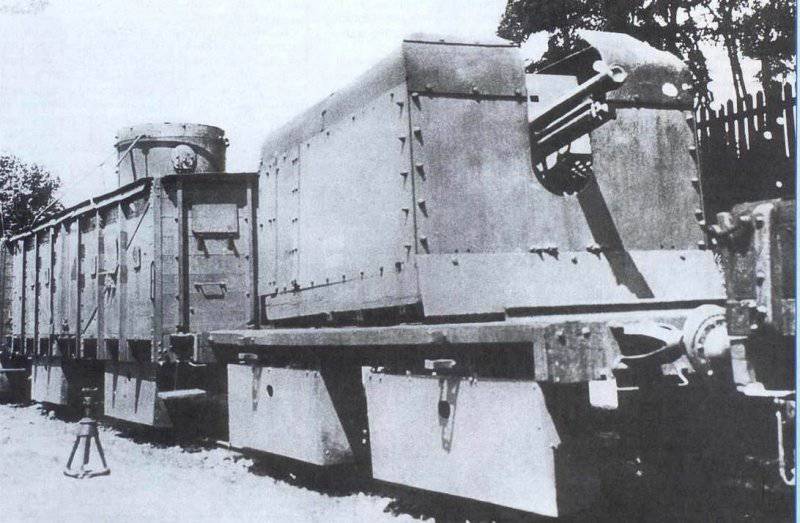
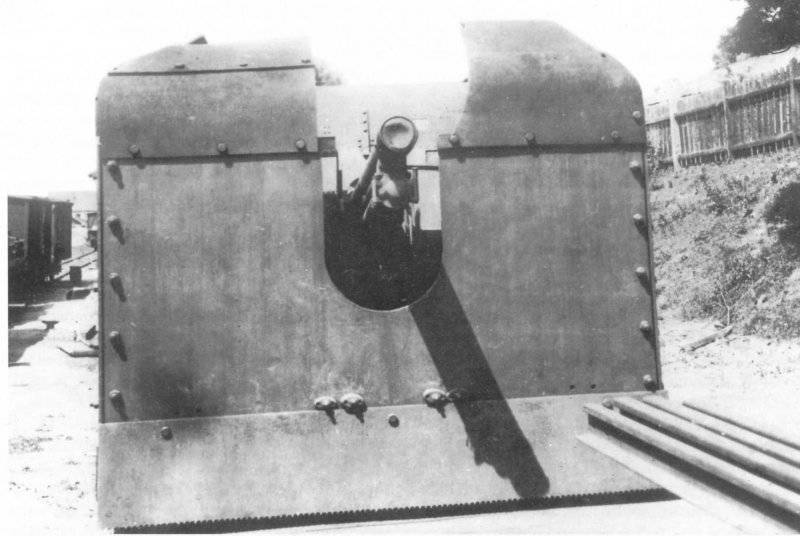
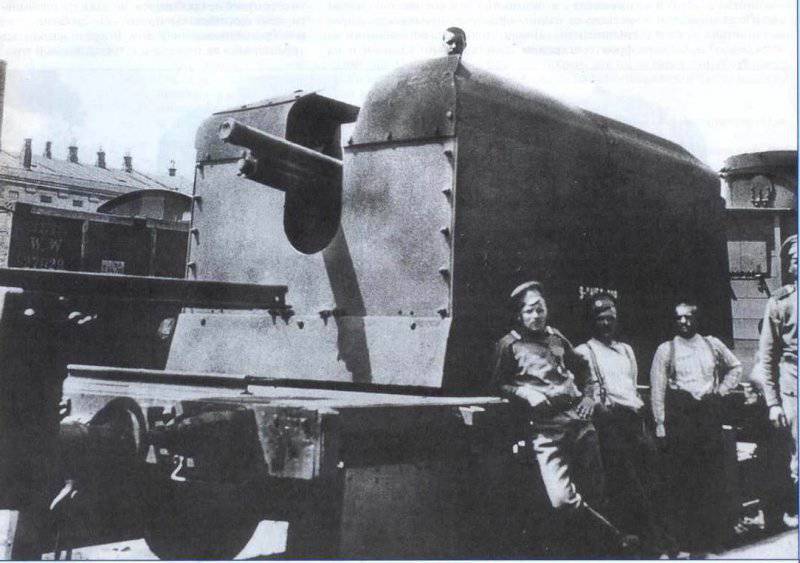
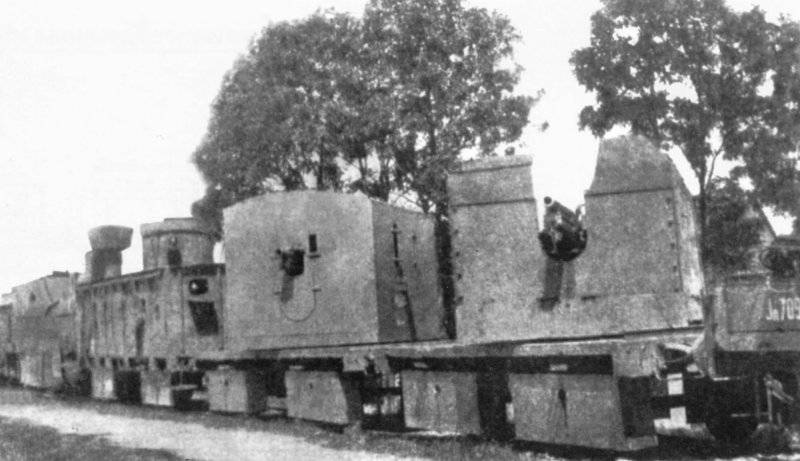

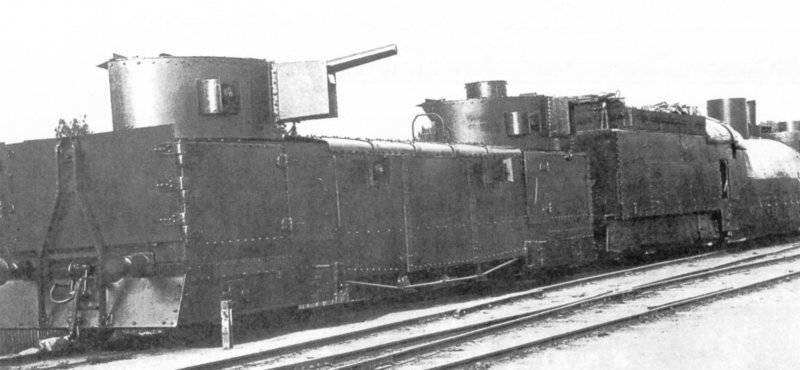
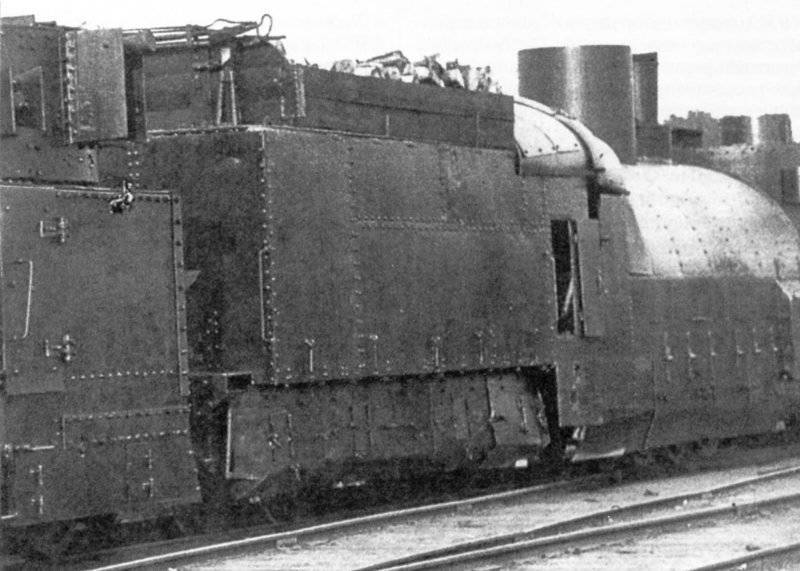
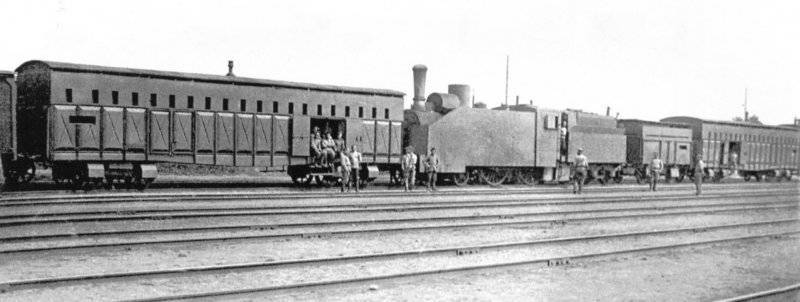
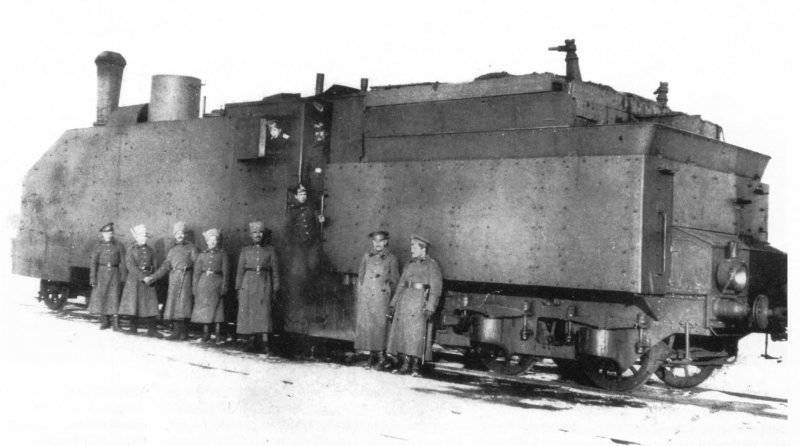
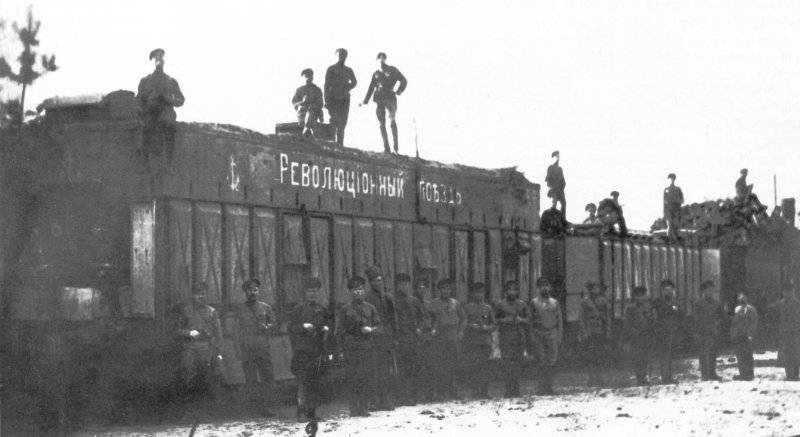
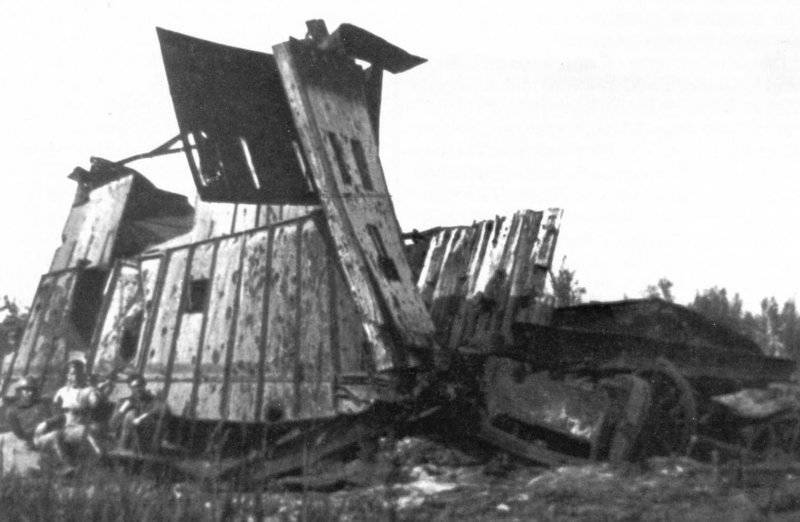
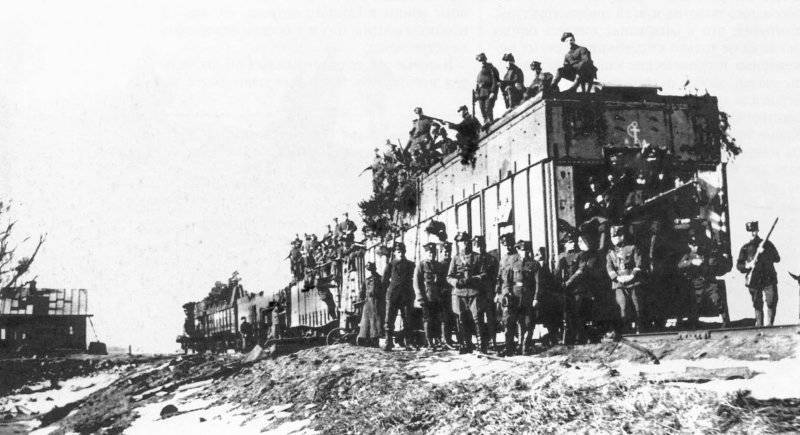
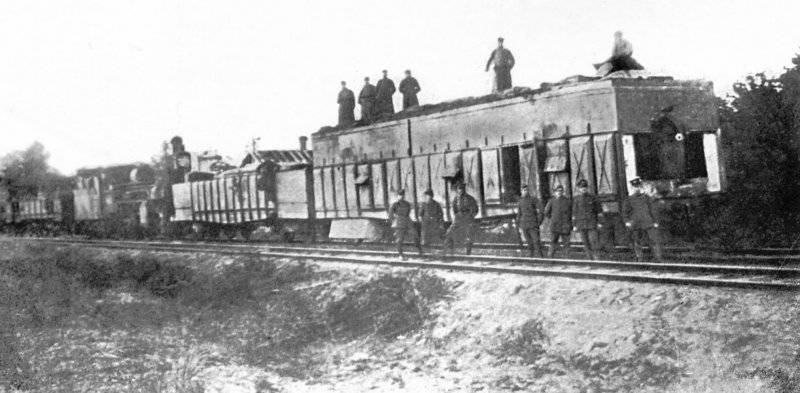
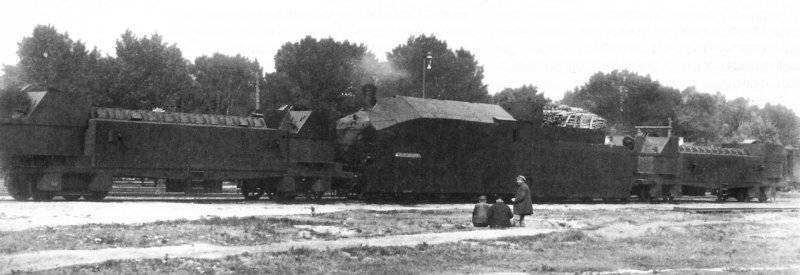
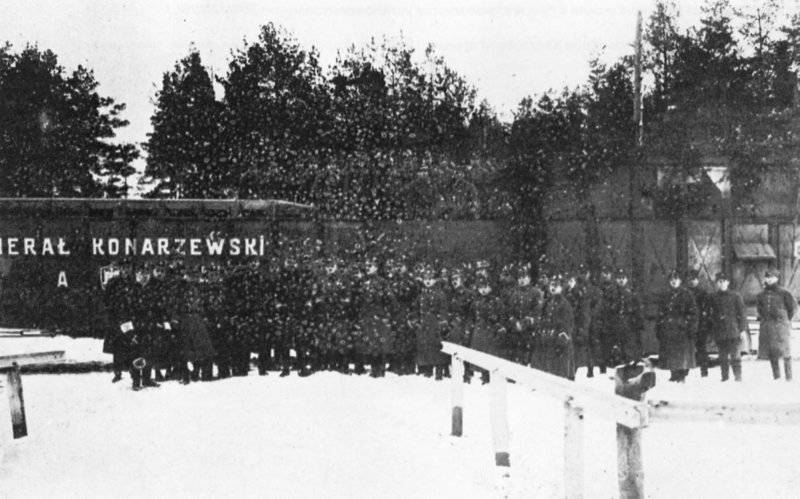
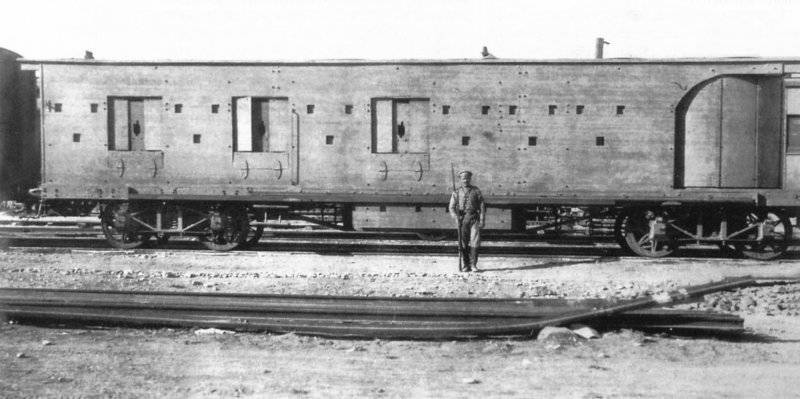
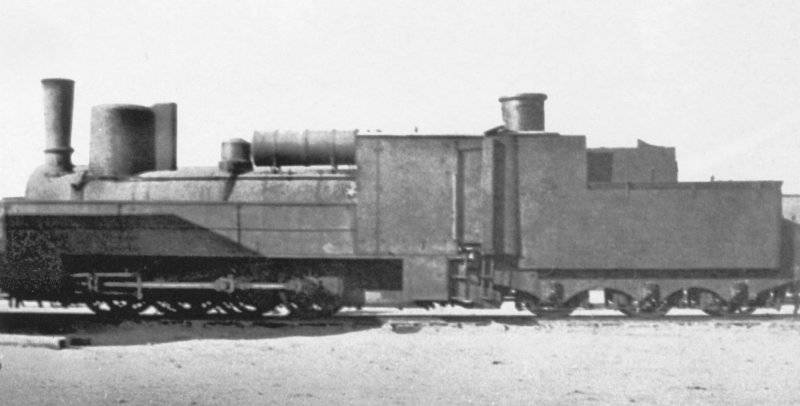
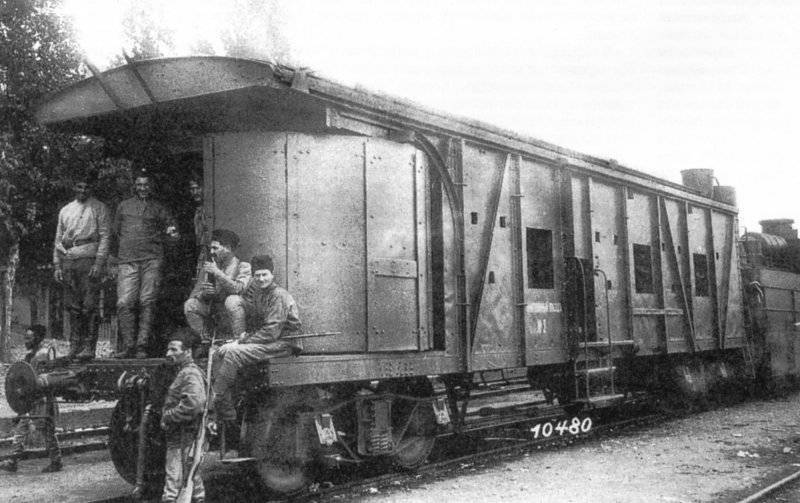
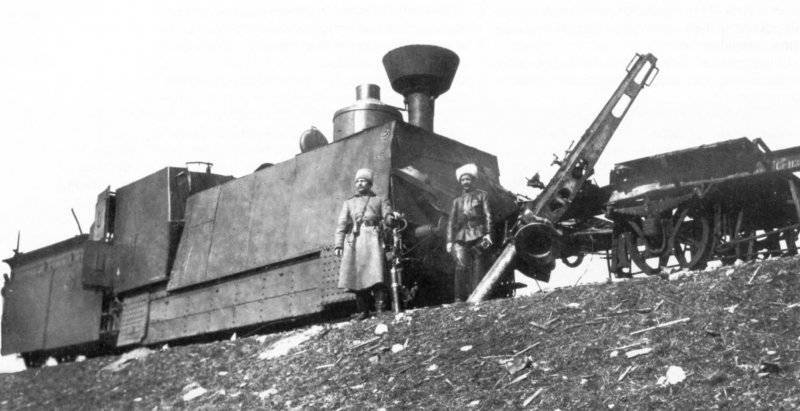
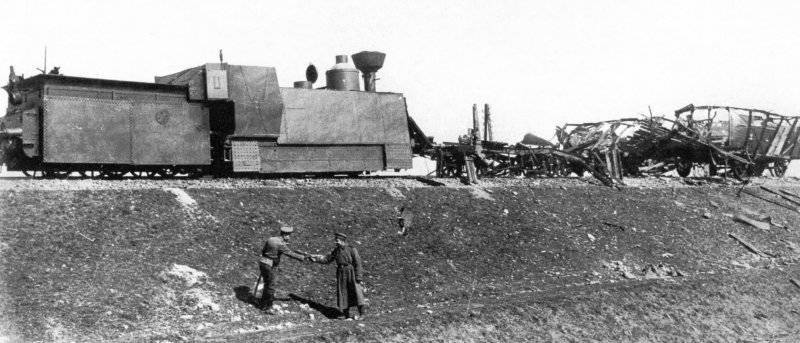
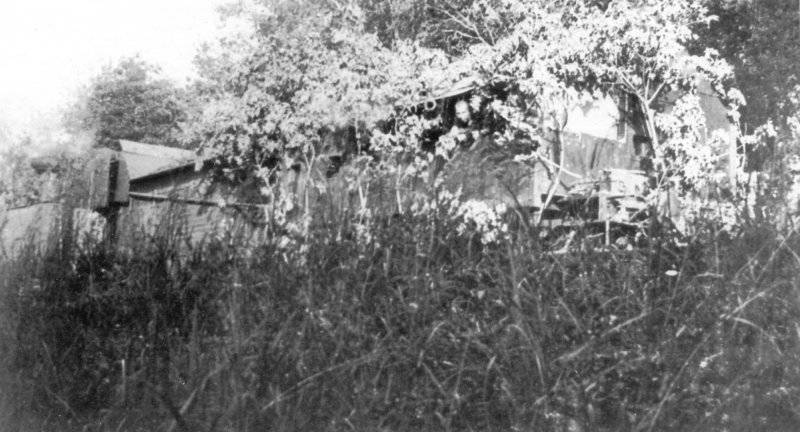
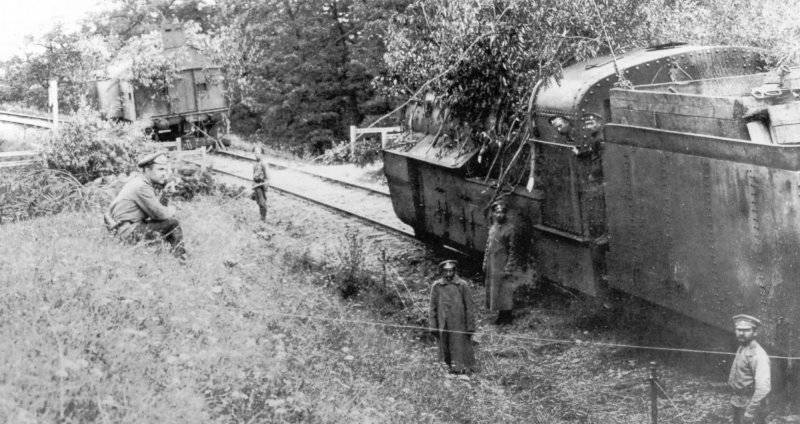
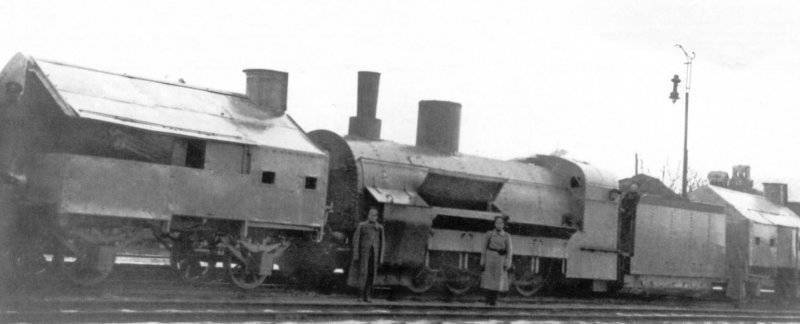

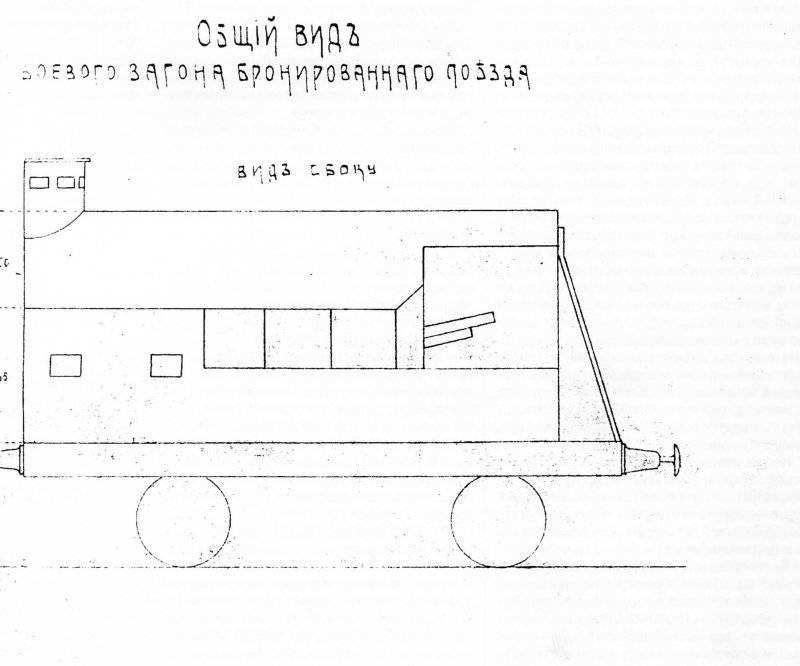
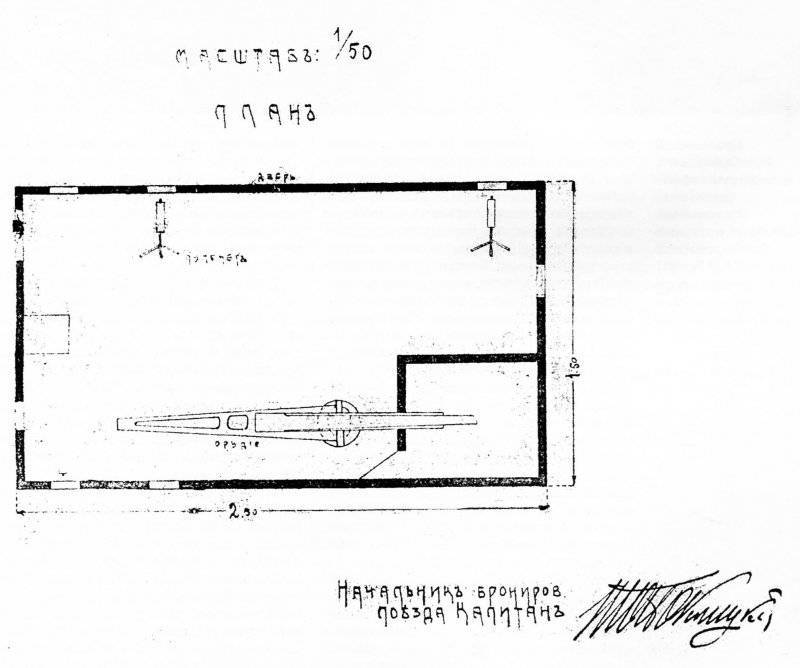
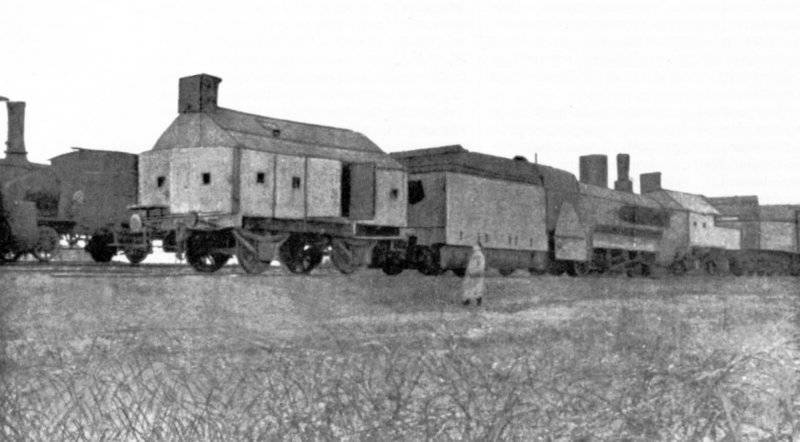
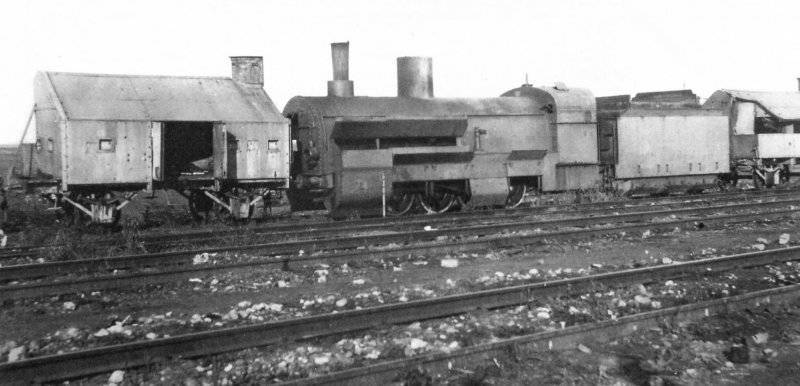
Information